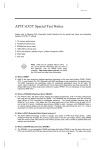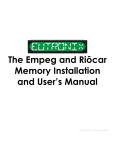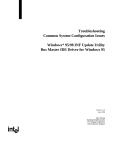Download AOpen AX5T User`s guide
Transcript
Appendix B Frequently Asked Question Note: FAQ may be updated without notice. If you cannot find the information that you need in this appendix, visit our WWW home page, (address: http://www.aopen.com.tw) and check the FAQ area and other new information. Q: How can I identify the mainboard BIOS version? A: The AOpen mainboard BIOS version appears on the upper-left corner of the POST (Power-On Self Test) screen. Normally, it starts with R and is found in between the model name and the date. For example: AP53/AX53 R3.80 Oct.22.1996 BIOS revision Q: How can I identify version of the mainboard? A: The AOpen mainboard version appears as ppppp-x on the PCB, near the PCI slot and is enclosed in a white bordered box. The ppppp is the project code used by AOpen internally and -x is the version code. For example, for AP5T with 95152 project code and -1 version code, the mainboard version appears on the PCB as follows: 95152-1 AP5T MB 48.87901.011 MB verison -1 (AP5T-1) B-1 Frequently Asked Questions Q: Why the AOpen mainboards (MB) do not have cache module expansion slot? A: Faster CPU speed requires more difficult and complex MB timing design. Every trace and components delay must be taken into consideration. The expansion cache slot design will cause 2 or 3ns delay in PBSRAM timing, and the extended trace length to the cache module through the golden finger will further delay the timing by 1 or 2ns. This may result in unreliable system once the cache module and slot becomes worn. All AOpen MBs support 512KB PBSRAM onboard. For better performance (around 3% higher than 256KB), we strongly recommend you to use 512KB onboard. Otherwise, reliable 256KB is better than unreliable 512KB with cache module. AOpen is the first company to promote this concept since the fourth quarter of 1995. Q: What is MMX? A: MMX is the new single-line multiple-instruction technology of the new Intel Pentium PP/MT (P55C) CPU. A new Pentium Pro CPU (Klamath) with MMX technology is also expected to be released soon. The MMX instructions are specifically useful for multimedia applications (such as 3D video, 3D sound, video conference). The performance can be improved if applications use these instructions. All AOpen MBs have at least dual power onboard to support PP/MT, it is not necessary to have special chipset for MMX CPU. Q: What is USB (Universal Serial Bus)? A: USB is a new 4-pin serial peripheral bus that is capable of cascading low/medium speed peripherals (less than 10Mbit/s) such as keyboard, mouse, joystick, scanner, printer and modem/ISDN. With USB, the traditional complex cables from back panel of your PC can be eliminated. You need the USB driver to support USB device(s). AOpen MBs are all USB ready, you may get latest BIOS from AOpen web site (http://www.aopen.com.tw). Our latest BIOS includes the keyboard driver (called Legacy mode), that simulates USB keyboard to act as AT or PS/2 keyboard and makes it possible to use USB keyboard if you don't have driver in your OS. For other USB devices, you may get the drivers from your device vendor or from OS (such as Win95). Be sure to turn off " USB Legacy Support" in BIOS "Chipset Setup" if you have another driver in your OS. Q: What is P1394? A: P1394 (IEEE 1394) is another standard of high-speed serial peripheral bus. Unlike low or medium speed USB, P1394 supports 50 to 1000Mbit/s and can be used for video camera, disk and LAN. Since P1394 is still under development, , there is no P1394 device currently available in the PC B-2 Frequently Asked Questions market. Also, there is no chipset that can support P1394. Probably in the near future, a card will be developed to support P1394 device. Q: What is SMBus (System Management Bus, also called I2C bus)? A: SMBus is a two-wire bus developed for component communication (especially for semiconductor IC). It is most useful for notebook to detect component status and replace hardware configuration pin (pull-high or pulllow). For example, disabling clock of DIMM that does not exist, or detecting battery low condition. The data transfer rate of SMBus is only 100Kbit/s, it allows one host to communicate with CPU and many masters and slaves to send/receive message. The SMBus may be used for jumpless mainboard, the components which support SMbus are not ready yet, we will keep eyes on it. Q: What is FCC DoC (Declaration of Conformity)? A: The DoC is new certif ication standard of FCC regulations. This new standard allows DIY component (such as mainboard) to apply DoC label separately without a shielding of housing. The rule to test mainboard for DoC is to remove housing and test it with regulation 47 CFR 15.31. The DoC test of mainboard is more difficult than traditional FCC test. If the mainboard passes DoC test, that means it has very low EMI radiation and you can use any kind of housing (even paper housing). Following is an example of DoC label. Currently, AOpen AX65/AP57/AP5T/AX5T had passed DoC test. AX5T Test To Comply With FCC Standards FOR HOME OR OFFICE USE Q: What is PBSRAM (Pipelined Burst SRAM)? A: For Pentium CPU, the Burst means reading four QWord (Quad-word, 4x16 = 64 bits) continuously with only the first address decoded by SRAM. The PBSRAM will automatically send the remaining three QWord to CPU according to predefined sequence. The normal address decoding time for SRAM is 2 to 3 clocks. This makes the CPU data read timing of four QWord to be at least 3-2-2-2 and a total of 9 clocks if traditional asynchronous SRAM is used. However, with PBSRAM, there is no need to decode address for rest three Qword. Therefore, data read timing can be 3-1-1-1, that is equivalent to 6 clocks and is faster than asynchronous SRAM. B-3 Frequently Asked Questions Q: What is EDO (Extended Data Output) memory? A: The EDO DRAM technology of EDO is actually very similar to FPM (Fast Page Mode). Unlike traditional FPM that tri-states the memory output data to start the pre-charge activity, EDO DRAM holds the memory data valid until the next memory access cycle, that is similar to pipeline effect and reduces one clock state. Q: What is SDRAM (Synchronous DRAM)? A: The SDRAM is a new generation DRAM technology that allows DRAM to use the same clock as the CPU host bus (EDO and FPM are asynchronous and do not have clock signal). The idea is the same as "Burst" (refer to the previous Q & A). It requires only one clock for the 2nd, 3rd, and 4th QWord (for example, 5-1-1-1 compares with EDO 5-2-2-2). The SDRAM comes in 64-bit 168-pin DIMM (Dual-in-line Memory Module) and operates at 3.3V. Note that some old DIMMs are made by FPM/EDO and only operate at 5V. Do not confuse them with SDRAM DIMM. AOpen is the first company to support dual-SDRAM DIMMs onboard (AP5V), from Q1 1996. Q: Can SDRAM DIMM work together with FPM/EDO SIMM? A: The FPM/EDO operate at 5V while SDRAM operates at 3.3V. The current MB design provides different power to DIMM and SIMM but connects the data bus together. If you combine SIMM and DIMM, the system will still work fine; however, only temporarily. After a few months, the SDRAM 3.3V data input will be damaged by 5V FPM/EDO data output line. Therefore, we strongly NOT recommend DIMM and SIMM combined together. There is one exception, if your SDRAM supports 5V tolerance (such as TI or Samsung), which accepts 5V signal at 3.3V operating power, you can combine them. Manufacturer Model Samsung NEC Micron TI TI KM416S1120AT-G12 D4516161G5-A12-7JF MT4LC1M16E5TG-6 TMS626162DGE -15 TMS626162DGE M-67 Q: What is Bus Master IDE (DMA mode)? B-4 Suggested CAS Latency Time 2 2 2 2 3 5V Tolerance Yes No No Yes Yes Frequently Asked Questions A: The traditional PIO (Programmable I/O) IDE requires the CPU to involve in all the activities of the IDE access including waiting for the mechanical events. To reduce the workload of the CPU, the bus master IDE device transfers data from/to memory without interrupting CPU, and releases CPU to operate concurrently while data is transferring between memory and IDE device. You need the bus master IDE driver and the bus master IDE HDD to support bus master IDE mode. Note that it is different with master/slave mode of the IDE device connection. For more details, refer to section 2.3 "Connectors". Q: What is the Ultra DMA/33? A: This is the new specification to improve IDE HDD data transfer rate. Unlike traditional PIO mode, which only uses the rising edge of IDE command signal to transfer data, the DMA/33 uses both rising edge and falling edge. Hence, the data transfer rate is double of the PIO mode 4 or DMA mode 2. (16.6MB/s x2 = 33MB/s). The following table lists the transfer rate of IDE PIO and DMA modes. The IDE bus is 16-bit, which means every transfer is two bytes. Mode PIO mode 0 PIO mode 1 PIO mode 2 PIO mode 3 PIO mode 4 DMA mode 0 DMA mode 1 DMA mode 2 DMA/33 Clock per 33MHz PCI 30ns 30ns 30ns 30ns 30ns 30ns 30ns 30ns 30ns Clock count Cycle time Data Transfer rate 20 13 8 6 4 16 5 4 4 600ns 383ns 240ns 180ns 120ns 480ns 150ns 120ns 120ns (1/600ns) x 2byte = 3.3MB/s (1/383ns) x 2byte = 5.2MB/s (1/240ns) x 2byte = 8.3MB/s (1/180ns) x 2byte = 11.1MB/s (1/120ns) x 2byte = 16.6MB/s (1/480ns) x 2byte = 4.16MB/s (1/150ns) x 2byte = 13.3MB/s (1/120ns) x 2byte = 16.6MB/s (1/120ns) x 2byte x2 = 33MB/s Q: What is the performance of Ultra DMA/33? Do we need special driver? A: You need driver to activate DMA/33, there are now driver from INTEL or you can use driver in the Windows 95 Memphis, which can recognize South Bridge PIIX4. We got the mass production sample Quantum Fireball ST1.6A, following are the test result. B-5 Frequently Asked Questions MB CPU DRAM VGA CDROM OS : AOpen AP5T : P54C-200 Mhz : 16MB * 2 (FP-7) : AOpen PV60 : AOpen CD-920E (20X) : Win95 OSR2 Model OS/Driver Mode Quantum Fireball 1.2G Quantum Fireball 1.2G Quantum ST1.6A Quantum ST1.6A Windows 95 OSR2 PIO mode 4 DMA mode 2 PIO mode 4 DMA/33 Windows 95 OSR2 + INTEL PIIX4 driver Windows 95 OSR2 Windows 95 OSR2 + INTEL PIIX4 driver Winbench97 Disk Winmark (Business) 717 Winbench97 Disk Winmark (High End) 2150 822 3050 853 2630 1040 4020 Q: What is PnP (Plug and Play)? A: In the past, the IRQ/DMA and memory or I/O space of add-on cards are normally set manually, i.e., by jumper or by proprietary utility. The user has to check the user's guide for the correct setting. Sometimes, resource conflict occurs and this leads to unstable system. The PnP specification suggests a standard register interface for both BIOS and OS (such as Win95). These registers are used by BIOS and OS to configure system resource and prevent any conflicts. The IRQ/DMA/Memory will be automatically allocated by PnP BIOS or OS. Currently, almost all the PCI cards and most ISA cards are PnP compliant. If you are still using a Legacy ISA card that cannot support PnP, set the corresponding resource (IRQ/DMA/memory) to ISA in the BIOS "PCI/PnP Setup". Q: What is ACPI (Advanced Configuration & Power Interface) and OnNow? A: The ACPI is new power management specification of 1997 (PC97). It intends to save more power by taking full control of power management to operating system and not through BIOS. Because of this, the chipset or super I/O chip needs to provide standard register interface to OS (such as Win97) and provides the ability for OS to shutdown and resume power of different part of chip. The idea is a bit similar to the PnP register interface. ACPI defines momentary soft power switch to control the power state transition. Most likely, it uses the ATX form factor with momentary soft power switch. The most attractive part of ACPI for desktop user is probably the "OnNow" feature, an idea from notebook. This feature allows you to B-6 Frequently Asked Questions immediately resume to your original work without the long time waiting from bootup, entering Win95 and running Winword. The AX5T with Intel TX chipset can support ACPI. Q: What is ATX Soft Power On/Off and Momentary Switch? A: The Soft Power On of the ATX specification means to provide a standby current for special circuit to wait for wakeup event when main power is off. For example, Infrared wakeup, modem wakeup, or voice wakeup. Currently, the most simple usage is to provide standby current for power switch circuit so that power switch can turn on/off the main power through soft power control pin. The ATX power specification does not mention anything about the power switch type. You can use toggle or momentary switch, note that ACPI specification requires momentary switch for power state control. All the AOpen ATX MBs support momentary switch and AX5T/AX58/AX6L support modem wakeup (Modem Ring-On). Soft Power Off me ans to turn off system through software, Windows 95 Shutdown function can be used to verify if your mainboard supports soft power off. AOpen AX5T/AX58/AX6F/AX6L support soft power off. Q: What is the AGP (Accelerated Graphic Port)? A: AGP is a PCI-like bus interface targeted for high-performance 3D graphic. AGP supports only memory read/write operation and single-master singleslave one-to-one only. The AGP uses both rising and falling edge of the 66MHz clock and produces 66MHz x 4byte x 2 = 528MB/s data transfer rate. The AOpen AX6L MB are designed to support AGP via the new Intel Klamath LX chipset. Q: Which Pentium chipset has the best performance? A: The performance difference of chipset depends on what kind of DRAM they use and the DRAM timing they support. (They all use PBSRAM, so that the difference is very little at 2nd level cache.) The following table lists the read timing of current available chipsets. The four digital represents the clocks needed for 1st-2nd-3rd-4th QWord. Notice that the Intel HX + EDO or SIS 5571+ EDO are almost the same as VX + SDRAM and the TX + SDRAM has the best performance among Pentium chipsets. Please note AP57 does not support SDRAM. P5 Chipset Model PBSRAM FPM EDO SDRAM B-7 Frequently Asked Questions Intel 430FX Intel 430VX Intel 430HX Intel 430TX SIS 5571 SIS 5582 AP5C/P AP5VM/ AP5V AP53/ AP5K/ AX53 AP5T/ AX5T AP57 AP58/ AX58 3-1-1-1 3-1-1-1 7-3-3-3 6-3-3-3 7-2-2-2 6-2-2-2 NA 6-1-1-1 3-1-1-1 6-3-3-3 5-2-2-2 NA 3-1-1-1 6-3-3-3 5-2-2-2 5-1-1-1 3-1-1-1 3-1-1-1 5-3-3-3 5-3-3-3 4/5-2-2-2 4/5-2-2-2 (6/7-1-1-1) 6/7-1-1-1 Q: What is the memory performance improvement of TX chipset? A: Following is the compare table of TX+SDRAM, VX+SDRAM, TX+EDO, HX+EDO and VX+EDO. CPU DRAM HDD VGA OS : Pentium PP/MT (P55C) 200MHz :16MB EDO or SDRAM : Quantum Fireball 1280AT : AOpen PV60 S3 Trio64V+ 800x600x256 Small font : Windows 95 OSR2 Chipset Model DRAM Timing Intel 430VX Intel 430HX Intel 430TX Intel 430VX Intel 430TX AP5VM AP53/AP5K AP5T/AX5T AP5VM/AP5V AP5T/AX5T EDO EDO EDO SDRAM SDRAM 6-2-2-2 5-2-2-2 5-2-2-2 6-1-1-1 5-1-1-1 Winstone9 6 86.1 86.8 87.3 86.6 87.7 Q: Does Pentium or Pentium Pro MB support Deturbo mode? A: The Deturbo mode was originally designed to slow down CPU speed for old applications (especially old games). It uses programming loop to wait or delay special event. This programming method is considered very bad since the delay of loop highly depends on the CPU speed and the application fails at high-speed CPU. Almost all new applications (including games) use RTC or interrupt to wait event. There is no need for Deturbo mode now. The Turbo switch is now used as Suspend switch. However, some MBs still support Turbo/Deturbo function via keyboard. You can set the system to B-8 Frequently Asked Questions Deturbo by pressing <Ctrl> <Alt> <->. To back to Turbo mode, press <Ctrl> <Alt> <+>. Note that the Deturbo mode has been removed in new MBs since these require more code space in Flash ROM. Q: Power Management Icon does not appear in the Windows 95 Control Panel even though the APM under BIOS Setup is enabled. A: This problem occurs if you did not enable the APM function before you install Windows 95. If you have already installed Windows 95, re-install it after the BIOS APM function is enabled. Q: Why does the system fail to go into suspend mode under Win95? A: This problem may be caused by your CDROM settings. The CDROM Auto Insert Notification of Win95 is dafault enabled, the system will continue to monitor your CDROM, auto-execute application when a CD diskette is loaded, and prevents the system from entering into suspend mode. To resolve this, go into Control Panel System Device Manager CDROM Setting, and disable the "Auto Insert Notification" function. Q: What is Windows 95 Registry? A: The functions of Windows 95 Registry and the Windows 3.1 INI files are almost the same. Both store the hardware and software configurations. The only difference is that Registry is a database while INI is text file. You can run REGEDIT.EXE to further understand the Registry structure. Checking and studying the structure of this file will help you solve some configuration problems. Q: Why are there question marks or "standard IDE controller" presented under Device Manager after installing Win'95 on AP5T/AX5T based system? A: Intel has introduced 430TX chipset with latest feature of "ACPI", "USB" & "Ultra DMA/33". Since these devices are so new that Win'95 did not anticipate to support them on Aug. of '95 which Win'95 initially is being released. Under Win'95 Device Manager, you may see following devices installed: -Other Devices ? PCI Bridge ? PCI Card (or PCI Universal Serial Devices) -Hard Disk Controllers Standard Dual PCI IDE Controller B-9 Frequently Asked Questions Primary IDE Controller Secondary IDE Controller PCI Bridge: This device stands for the "ACPI" feature which implemented within PIIX4(82371AB) chipset. This new feature is expected to be fully utilized under Windows'97(Memphis). Please look for more details on ACPI from FAQ "What is ACPI?". PCI Card: There is driver ne cessary in order to support Universal Serial Device under Win'95. Microsoft has implemented the driver since Win'95 OEM Service Release 2.1 (OSR 2.1) & it will recognize USB port without any problem. Pleae contact your USB device vendor or system vendor of more inforamtion. Also, more details for USB in the FAQ of "What is USB?". Standard Dual PCI IDE Controller: The IDE controller chipset -- PIIX4 -- will be fully recognized under Windows'97 also. In the mean while, you may download the driver for Win'95 from AOpen homepage at "http://www.aopen.com.tw" which supports both Bus Mastering & Ultra DMA/33. After installation, you should be able to see Win'95 recognize it under Device Manager as below: -Hard Disk Controllers Intel 82371AB PCI Bus Master IDE Controller Primary Bus Master IDE Controller Secondary Bus Master IDE Controller Even though all of above are the current limitations of Win'95 on Intel 430TX chipset which are expected to implement on Win'97, your system still can enjoy the best performance of AP5T/AX5T without any problem. Q: Which version of the Windows '95 that I am using? A: You may determine the version of Windows '95 by following steps. 1. Double click "System" in "Control Panel". 2. Click "General". 3. Look for "System" heading & refer to following, 4.00.950 4.00.950A B-10 Windows 95 Windows 95 + Service Pack or OEM Service Release 1 Frequently Asked Questions 4.00.950B OEM Service Release 2 or OEM Service Release 2.1 If you are running OSR 2.1, you may tell it from by check ing "USB Supplement to OSR2" in the list of installed program of Add/Remove program tool under Control Panel, and checking for version 4.03.1212 of the Ntkern.vxd file in the Windows\System\Vmm32 folder. Q: What is the difference between AX5T-1 and AX5T-2? A: AX5T-2 fixes the ATX power supply to off state when you first time install your AX5T mainboard. AX5T-1 can be probably on or off. Note that currently, they all have 75MHz but without 83.3Mhz jumper setting because of clock generator limitation. The user set clock to 75MHz is taking his own risk, and is probably to have system unstable behavior. Item 75MHz jumper setting 83.3MHz jumper setting ATX Power Supply initial state AX5T-2 Yes No Off AX5T-1 Yes No Random Q: What is the difference of Linear Regulator and Switching Regulator? A: Switching regulator turns on/off Power FET with very high frequency and uses L/C charge and discharge circuit to do voltage drop. The efficient is better but voltage ripple and EMI noise is higher. The reason for mainboard designer to consider switching regulator, is simply because they are worry about linear regulator can not fully support the coming new CPU. Actually, this depends on the design and layout quality of mainboard manufacturer. According to AOpen RD's testing, Intel PP/MT-233, AMD K6-166/200/233 are all fine on AP5T to run winstone97. (The CPU is at 53 degree C, heatsink is at 60 degree C and regulator IC is at 79 degree C). But for future CPU (perhaps CPU of 1998), AOpen will still consider to phase-in switching regulator on new version mainboard. Q: What is the performance improvement of AMD K6? A: Following is the compare table of the new generation CPU. DRAM : 64MB EDO HDD : Quantum Fireball 1280AT VGA : Matrox Millennium VGA, 4MB, 1024x768 24bit, 85Hz. B-11 Frequently Asked Questions OS : Windows 95 4.00.950 CPU MB Chipset Winstone97 Winstone97 Business High-End PP/MT 200 PP/MT 233 K6 PR200 * K6 PR210 (83.3MHz x 2.5) K6 PR233 * K6 PR250 (83.3MHz x 3) AP5T/AX5T AP5T/AX5T AP5T/AX5T AP5T Intel 430TX Intel 430TX Intel 430TX Intel 430TX 48.3 50.5 50.3 51.2 21.9 23.6 22 23 AP5T/AX5T AP5T Intel 430TX Intel 430TX 51.7 54 23.6 24.8 You can see that K6-233 is better than PP/MT-233 on Business Winstone97, but the High-End graphic Winstone97 is almost the same. Note that, if you over-clock K6 to 250M (83.3MHz*3), it could be the fastest socket -7 system among all. But please be reminded, it is your own risk to over-clock Q: When can we have real jumperless mainboard? A: PnP had achieved the goal of jumperless add-on card, but true jumperless mainboard still has some technical concerns. For example, CPU clock and voltage do not have standard interface. Currently, the so called jumperless mainboard is actually depends on the BIOS to detect or manually set the CPU clock and voltage. If the setting is wrong, it will cause system unstable or damage after long time use. The other disadvantage is, because some of the jumper setting information is stored in CMOS, if the battery is lost or BIOS setup is accidentally changed, end user (or distributor) may need to open the housing and check the CPU again. Most of all, you need a start voltage to boot CPU and go into BIOS for jumperless setting. 2.85V may be OK for P55C and K6-166, but minimum voltage of K6-233MHz is 3.1V, it can not boot if user plugs K6-233 onto current jumperless mainboard. We probably need to wait after the mature of SMbus, if CPU and clock generator and other ICs are all SMbus compliance. Chipset can then detect and report the system configuration right after power on. Then we can have true jumperless mainboard. Q: What is LDCM (LAN Desktop Client Manager)? B-12 Frequently Asked Questions A: This is a software of Intel. The major goal is to provide an easy way for corporate network administrator to monitor the status of all the clients (workstation). You need at least DMI BIOS for LDCM. AOpen BIOS is also DMI ready but unfortunately, Intel LDCM needs Intel network card to work properly. It is obviously not suitable for home user to pay LDCM extra cost. B-13























